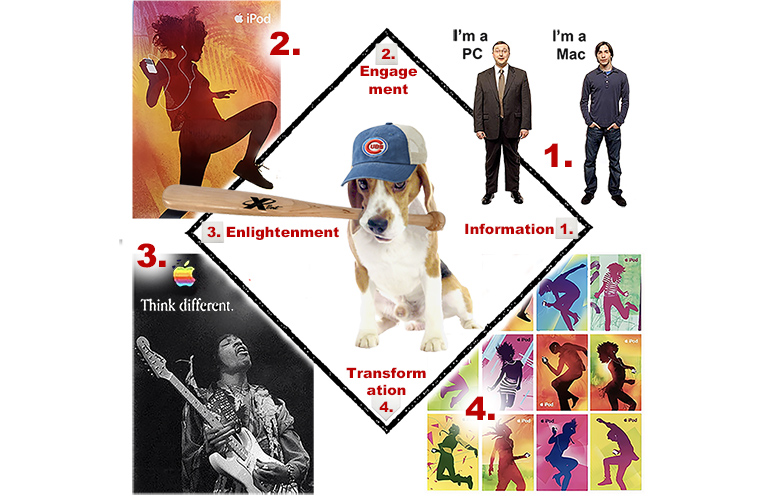[The wizard has been writing twice a month for Radio Ink magazine for more than a quarter century. The column you are about to read will be distributed to every radio station in North America – more than 10,000 of them – when it is published in a few weeks. – Indy Beagle]
Traditional wisdom would suggest that a writer offering advice to Radio professionals should focus on how to use Radio more effectively.
But traditional wisdom is usually more tradition than wisdom.
True wisdom is to know how every form of advertising works, not just the media you are trying to sell. When you can identify and communicate the markers of success in every type of advertising, you become a well-spring of insight, wisdom, and advice; a sustaining resource as refreshing as cold water on a hot day.
The things I am about to share with you are not focused on radio because they are not limited to radio. You have observed these things all your life; you just never took the time to organize your observations.
Your mind will whisper “Eureka” within the next few minutes. Listen for it.
When you are speaking face-to-face, voice-to-voice, in writing, or through the medium of advertising, there can be no communication until you have won the attention of your audience. To win attention, you must deliver a magnetic First Mental Image (FMI.)
There are three ways of delivering your FMI:
- When your FMI is delivered by voice, it is called an opening line.
The bright light of vivid verbs project action onto the movie screen of the mind. - When your FMI is delivered in printed words, it is called a headline, a title, or a subject line. You will need a second FMI for the opening line of your first paragraph. Vivid verbs are again the key. Verbs become vivid when they are accurate, but unexpected. Predictability is not your friend.
- Photographs, drawings, illustrations, and video clips win attention when the viewer enters into the world of that visual image to become a momentary participant in the scene.
Face-to-face, voice-to-voice, in writing, or through advertising, there can be no communication until you have won the attention of your audience.
Amateur ad writers will try to shock the audience. But it is much more effective to intrigue the audience by using one of the following five methods.
The most straightforward methods are these two:
- A simple declarative statement: “70% of people over 50 have sore knees.”
- A customer testimonial: “My knee pain went away when I put these insoles in my shoes.”
The next three techniques employ what I call “The Hovering Question Mark,” since they are designed to trigger curiosity by delivering an incomplete message.
- A question aimed at the reader, listener, or viewer: “Do you have sore knees?”
- An incomplete sentence: “I first noticed my knees were sore when…”
- A metaphor that begs for context: “I had a headache behind my kneecap.”
Any of these 5 techniques can be used to get attention, but you’re still a long way from making the sale. Your bat has merely contacted the ball.
Amateur ad writers – having made contact – will immediately switch into “AdSpeak,” that predictable, despicable language of bone-breakingly-boring ads. This is called clickbait when it’s done online. It’s called a rookie maneuver when it’s done in any other media. When it’s truly pathetic, it’s called a clown show.
Amateur ad writers move from attention-getting into AdSpeak because they believe their job is merely to deliver information about the product. But information will take you only to 1st base, and there are 4 bases you must touch before you score.
1. Information
2. Engagement
3. Enlightenment
4. Transformation
Getting the momentary Attention of an audience and delivering a piece of Information is relatively easy. Holding their attention is more difficult (Engagement). We must provide a new perspective if we hope to cause a listener to think and feel differently (Enlightenment). Only then will they be changed (Transformation).
Getting attention is not enough. Delivering Information is not enough. You must Engage the listener, bring them Enlightenment, and see them Transformed from listener into customer.
You must cause the undecided to decide, the unbeliever to believe, and the blind to see.
And you must do it in 60 seconds.
Or maybe 30.
Welcome to Radio.
Roy H. Williams
 Most people fail to say their own name correctly. Odd as that may sound, Laura Sicola explains her assertion in a YouTube video that is approaching 7 million views. Dr. Sicola earned her PhD in educational linguistics and has two decades of experience teaching good vocal habits to executives at companies including Comcast, IBM, and Vanguard. As she explains to roving reporter Rotbart, how you introduce yourself determines how effectively you will convey the messages that follow.This is true whether you are speaking to a room from a podium or meeting a person one-on-one for the first time. How well do you articulate your name? Say it, say it, say it: MondayMorningRadio.com
Most people fail to say their own name correctly. Odd as that may sound, Laura Sicola explains her assertion in a YouTube video that is approaching 7 million views. Dr. Sicola earned her PhD in educational linguistics and has two decades of experience teaching good vocal habits to executives at companies including Comcast, IBM, and Vanguard. As she explains to roving reporter Rotbart, how you introduce yourself determines how effectively you will convey the messages that follow.This is true whether you are speaking to a room from a podium or meeting a person one-on-one for the first time. How well do you articulate your name? Say it, say it, say it: MondayMorningRadio.com
